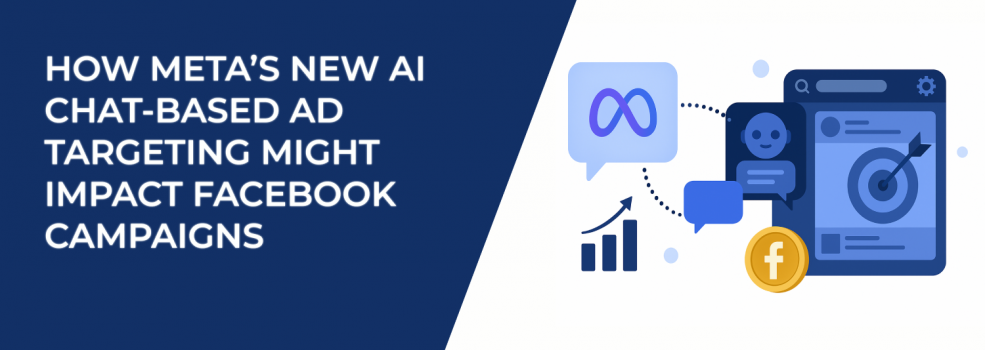Meta just announced a big change. Starting December 16, 2025, conversations people have with its AI tools — whether typed or spoken — will help shape the ads and content they see on Facebook, Instagram, and other Meta apps.
This update could shake up the way advertisers run their campaigns. It might make targeting sharper, but it could also make ads feel a little too personal. Let’s look at what’s happening, why it matters, and what you should be doing to prepare.
What’s Changing: Conversations Become Ad Signals
Until now, Facebook ad targeting has mostly used things like likes, clicks, follows, and browsing activity. With this update, what people actually say to Meta’s AI will be added as a new signal.
For example, if someone asks the AI about the best hiking boots, they could start seeing ads for outdoor gear. It’s a clearer sign of intent than simply liking a hiking page, and that makes it powerful.
Here are the main points:
-
Sensitive topics like politics, health, and religion won’t be used.
-
The rollout won’t happen everywhere — countries like the UK, EU nations, and South Korea won’t be included for now.
-
Users will get notified before the change kicks in.
-
If someone uses AI chat, they can’t opt out of their conversations being used for ad targeting.
In short, conversations are becoming ad fuel. This comes alongside other AI-driven updates in Meta’s ecosystem, like its expanding use of AI text and image generators to help advertisers quickly produce content. Together, these tools show just how central AI is becoming to campaign performance.
Why It Matters for Facebook Advertisers
This update isn’t just another small tweak. It’s a whole new way of finding and understanding audiences.
Richer Signals of Intent
When people talk to AI, they’re often very clear about what they want — “I need a budget laptop,” or “I’m planning a trip to Patagonia.” That’s much stronger than a casual like or follow. Advertisers may see more precise audiences and quicker shifts in user interests.
Organic and Paid Are More Connected
AI chat activity will shape both the content people see for free and the ads they’re shown. The line between asking and receiving is getting very thin. This means your organic content and paid ads need to feel connected and natural, almost like they’re part of the same conversation.
More Pressure on Ad Creative
If ads are matched to what people are saying in chats, the copy and headlines will need to reflect that style of language. Ads that don’t sound conversational could miss the mark, while ads that feel like a natural reply might stand out.
Attribution Will Get Tricky
Layering chat data on top of everything else may cause:
-
Audience overlaps to shift.
-
Campaign performance to swing in unexpected ways.
-
New micro-segments to pop up based on chat patterns.
As with the recent Facebook ads targeting updates, advertisers will need to stay agile. Attribution will require more testing and validation than ever.
How Advertisers Can Prepare
You don’t need to wait for December. Here’s how you can start adapting now.
Make Ads Sound Conversational
Check your current ads. Do they sound like something a person would actually type into chat? Phrases like “help me find” or “what’s the best” are a good start. Shaping ad copy around natural language will make it easier for your ads to connect with real intent.
Try Question-Style Hooks
Test headlines that feel like part of a conversation. Think: “Looking for the best way to…” or “Which option works for you?” Run dynamic creative to see which variations connect best with your audience.
Watch Your Audiences Closely
As this rolls out, audiences may shift in ways you don’t expect. Run tests comparing traditional targeting with conversational-style targeting. Keep an eye out for overlaps that could eat into efficiency.
Publish Content That Matches Chat Themes
Don’t just focus on ads. Create posts, videos, and Q&As that echo the types of questions people ask in chat. This can help feed the AI signals that point users toward your brand.
Keep Budgets Flexible
Hold back a portion of your budget for testing once the update goes live. Put performance guardrails in place — like stricter CPA targets — to protect your spend while you experiment. And be ready for CPMs to rise at first as the system adjusts.
Advertisers already experimenting with AI-powered Facebook ad tools will have a head start here, since they’re used to adjusting creative and targeting in real time.
Risks and Criticisms
There’s no doubt this update comes with risks. Privacy is the biggest one — users may not like the idea that their conversations feed into ads. Transparency is another issue, since it’ll be harder to know exactly why certain ads are shown.
AI may also misread signals. Sarcasm, sloppy wording, or vague questions could create poor targeting. And conversational ads, while engaging at first, may burn out faster and require more frequent refreshes. The biggest danger is user backlash. If people feel ads are too close to what they just said to the AI, they might stop using chat tools altogether.
It’s a reminder that while AI is reshaping Facebook ads, advertisers must use these new tools carefully, respecting boundaries while testing new opportunities.
What to Watch After Rollout
When the update goes live, watch for shifts in key metrics like CTR, CPM, and conversion rates. You may discover new micro-segments emerging, while older audiences start behaving differently. Creative fatigue could also become a bigger issue, with conversational-style ads needing faster refresh cycles.
Attribution will need a closer look. Just because someone mentioned a product in chat doesn’t mean that’s what led to a purchase. Testing and validation will be critical. And finally, keep an eye on user behavior. If people start avoiding AI chat, the strength of these new signals could fade.
Final Thoughts
Meta’s move to use AI chat data for ad targeting could reshape Facebook campaigns in a big way. It promises sharper signals and new opportunities, but it also brings risks: privacy concerns, creative fatigue, and more complicated attribution.
Here’s what you can do now:
-
Rewrite some of your ad copy to sound more like natural conversation.
-
Run small tests with question-style hooks.
-
Keep part of your budget flexible so you can test once the update is live.
-
Refresh your creative pipeline so you’re ready for quicker turnover.
-
Put user trust first — if your ads feel invasive, performance will suffer.
The advertisers who treat this change as a chance to experiment and adapt will gain an edge, while others will be left reacting too late.

